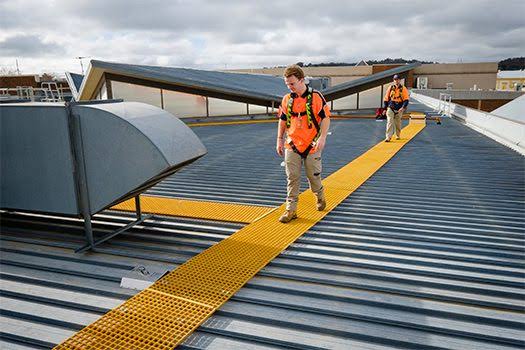Roof walkway systems are more than just practical additions to commercial and industrial buildings—they are essential components that enhance both efficiency and safety in various operational aspects. From ensuring safe access for maintenance personnel to protecting roof integrity, these systems play a crucial role in maximising the functionality and longevity of roofs.
Ensuring Safe Access
One of the primary benefits of a roof walkway system is its ability to provide safe and secure access to rooftops. In industrial settings, where regular maintenance and inspections are necessary, ensuring that workers can access rooftops safely is paramount. Roof walkway systems offer designated pathways that are equipped with anti-slip surfaces and guardrails, minimising the risk of slips, trips, and falls. This promotes a safer working environment by shielding employees from potential harm and guaranteeing adherence to safety rules.
Moreover, by delineating safe routes across rooftops, these systems help streamline access to equipment and service areas. This strategic layout reduces the time spent navigating rooftops, thereby enhancing operational efficiency and productivity. Workers can perform tasks more efficiently without compromising on safety, leading to overall cost savings and improved workflow management.
Preserving Roof Integrity
For every building owner, maintaining the structural integrity of their roof is essential to long-term sustainability as they are substantial investments. Roof walkway systems contribute to preserving roof integrity by minimising unnecessary foot traffic in vulnerable areas. These systems divert traffic away from vulnerable roofing components, like HVAC units, skylights, and vents, which might sustain damage from heavy loads or unintentional collisions by creating defined paths.
Furthermore, roof walkway systems are designed to evenly distribute the load across the roof surface. This load distribution prevents concentrated weight on specific areas, reducing the risk of roof damage and prolonging its lifespan. As a result, building owners can minimise repair and replacement costs associated with premature roof deterioration, making roof walkway systems a cost-effective investment in the long run.
Enhancing Emergency Preparedness
In emergencies such as fires or equipment failures, quick and safe access to rooftop equipment, fire exits, or ventilation systems is critical. Roof walkway systems facilitate rapid response by providing clear, designated pathways that emergency personnel can utilise without hindrance. These systems ensure that crucial areas are easily accessible, enabling efficient mitigation of emergency situations and minimising potential damage to property and personnel.
Moreover, during routine fire drills or safety inspections, roof walkway systems simplify access for safety officers and inspectors. This streamlined access ensures compliance with safety protocols and regulatory requirements, contributing to a proactive safety culture within the organisation.
Compliance With Regulations
Regulatory bodies often require buildings to adhere to specific safety standards, including provisions for safe rooftop access and maintenance. Roof walkway systems help organisations comply with these regulations by providing documented safe access routes and ensuring that all personnel are protected during rooftop activities. Compliance not only mitigates legal liabilities but also enhances the organisation’s reputation as a responsible and safety-conscious entity in the industry.
Conclusion
In commercial and industrial environments, roof walkway systems are invaluable tools that maximise productivity and safety. Building functioning and safety are greatly enhanced by these systems, which also maintain roof integrity, improve emergency preparedness, and guarantee regulatory compliance in addition to facilitating safe access. Investing in roof walkway systems is not just about meeting safety requirements—it is about safeguarding assets, optimising operational efficiency, and fostering a secure working environment for all stakeholders involved.






